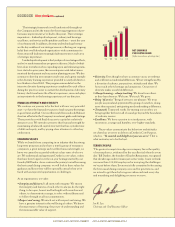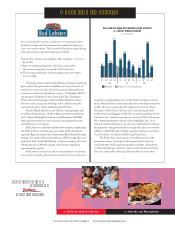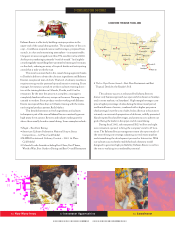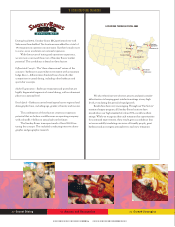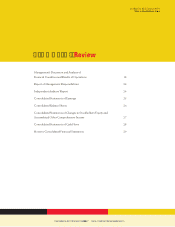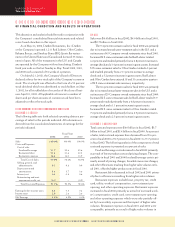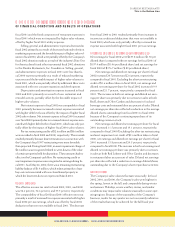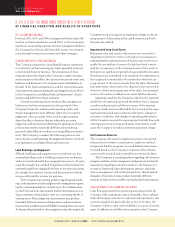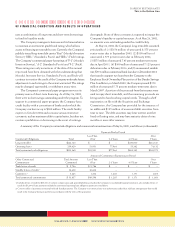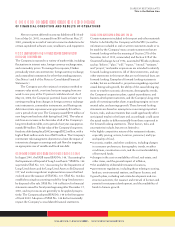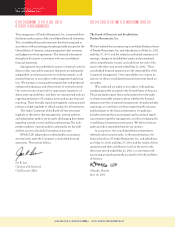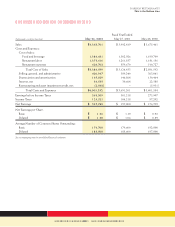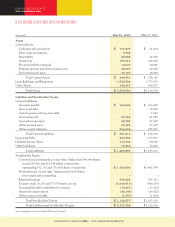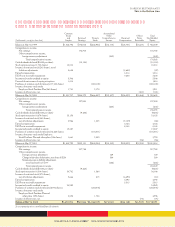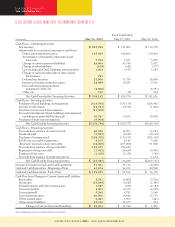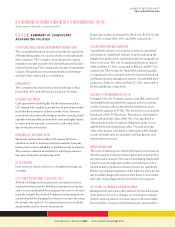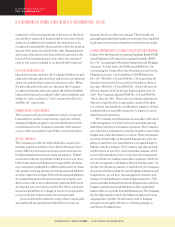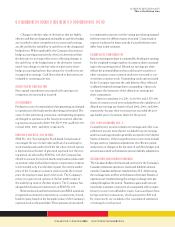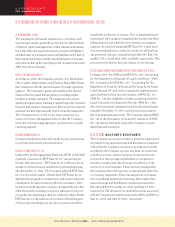Red Lobster 2002 Annual Report Download - page 25
Download and view the complete annual report
Please find page 25 of the 2002 Red Lobster annual report below. You can navigate through the pages in the report by either clicking on the pages listed below, or by using the keyword search tool below to find specific information within the annual report.
ManagementÕs Discussion and Analysis
OF FINANCIAL CONDITION AND RESULTS OF OPERATIONS
DARDEN RESTAURANTS
This is the Bottom Line
The Company’s adjusted debt to adjusted total capital
ratio (which includes 6.25 times the total annual restaurant
minimum rent and 3 times the total annual restaurant equipment
minimum rent as a component of adjusted debt and adjusted
total capital) was 46 percent and 44 percent at May 26, 2002,
and May 27, 2001, respectively. The Company’s fixed-charge
coverage ratio, which measures the number of times each
year that the Company earns enough to cover its fixed
charges, amounted to 6.8 times and 6.5 times at May 26, 2002,
and May 27, 2001, respectively. Based on these ratios, the
Company believes its financial condition remains strong. The
composition of the Company’s capital structure is shown in
the following table.
May 26, May 27,
(In millions) 2002 2001
CAPITAL STRUCTURE
Short-term debt $ – $ 12.0
Long-term debt 662.5 520.6
Total debt 662.5 532.6
Stockholders’ equity 1,128.9 1,033.3
Total capital $1,791.4 $1,565.9
ADJUSTMENTS TO CAPITAL
Leases-debt equivalent $ 294.6 $ 275.1
Adjusted total debt 957.1 807.7
Adjusted total capital 2,086.0 1,841.0
Debt to total capital ratio 37% 34%
Adjusted debt to adjusted total capital ratio 46% 44%
The Company’s Board of Directors has approved a stock
repurchase program that authorizes the Company to repur-
chase up to 96.9 million shares of the Company’s common
stock. Net cash flows used by financing activities included the
Company’s repurchase of 9.0 million shares of its common
stock for $209 million in fiscal 2002 compared to 12.7 million
shares for $177 million in fiscal 2001 and 17.2 million shares
for $202 million in fiscal 2000. As of May 26, 2002, a total of
86.3 million shares have been purchased under the program.
The stock repurchase program is used by the Company to off-
set the dilutive effect of stock option exercises and to increase
shareholder value. The repurchased common stock is reflected
as a reduction of stockholders’ equity.
Net cash flows used by investing activities included capital
expenditures incurred principally for building new restaurants,
replacing equipment, and remodeling existing restaurants.
Capital expenditures were $318 million in fiscal 2002, com-
pared to $355 million in fiscal 2001, and $269 million in fiscal
2000. The reduced expenditures in fiscal 2002 resulted pri-
marily from a reduction in renewal and replacement spending
at Red Lobster restaurants. The increased expenditures in fis-
cal 2001 resulted primarily from new restaurant growth. The
Company estimates that its fiscal 2003 capital expenditures will
approximate $400 million. Net cash flows used by investing
activities for fiscal 2002 also included the purchase of $32 mil-
lion of trust-owned life insurance policies that cover certain
Company officers and other key employees. The policies
were purchased to offset a portion of the Company’s obligations
under its non-qualified deferred compensation plan.
The Company is not aware of any trends or events that
would materially affect its capital requirements or liquidity.
The Company believes that its internal cash generating
capabilities and borrowings available under its shelf registra-
tion for unsecured debt securities and short-term commercial
paper program should be sufficient to finance its capital
expenditures, stock repurchase program, and other operating
activities through fiscal 2003.
Financial Condition
The Company’s current assets at May 26, 2002, totaled $450
million, a 37.0 percent increase over current assets of $328 mil-
lion at May 27, 2001. The increase resulted primarily from
increases in cash and cash equivalents of $91 million and
short-term investments of $10 million that resulted principally
from the short-term investment of proceeds received from
the March 2002 medium-term debt issuance. Inventories
also increased by $24 million primarily as a result of
opportunistic seafood purchases and purchases in support
of upcoming promotions.
Other assets of $159 million at May 26, 2002, increased
from $109 million at May 27, 2001, primarily as a result of the
purchase of $32 million of trust-owned life insurance policies
during fiscal 2002 as well as an increase in capitalized costs
associated with software improvements.
Current liabilities increased by $47 million compared to
fiscal 2001, primarily as a result of increases in accrued income
taxes, gift card and gift certificate payables, and employee
benefit related accruals.
Great Food and Beverage 22 Produce Great Results in 2002


